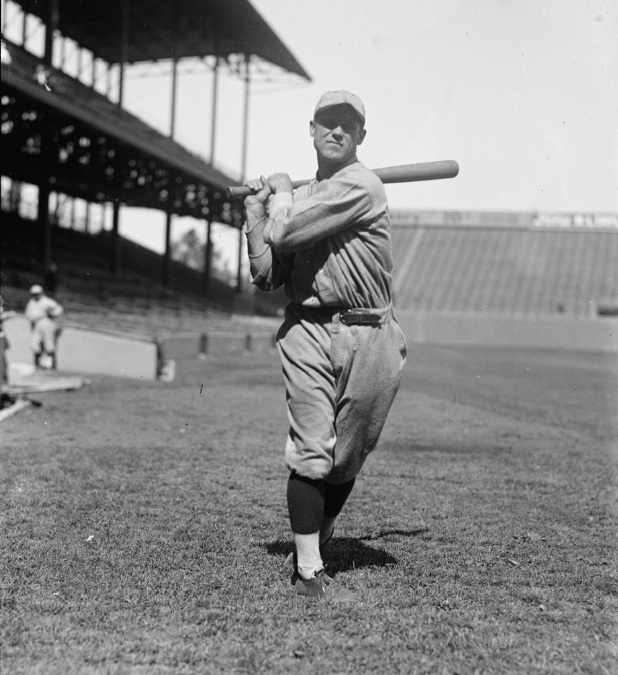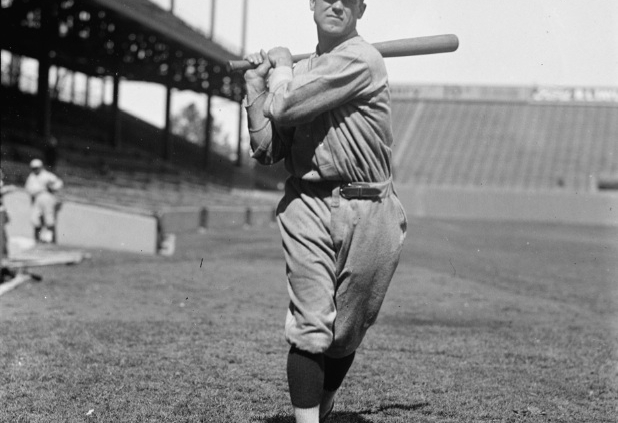August 30, 1921: George Sisler’s five hits lift St. Louis Browns into third place
 “Playing like real pennant chasers, the St. Louis Browns swamped the White Sox,” gushed the St. Louis Globe-Democrat.1 The Browns’ 28th victory in their last 40 games moved them into third place, a position the franchise had not experienced so late in the season since 1908, when they engaged in a tight four-team pennant-race. Though the 1921 Browns trailed the eventual pennant-winning New York Yankees by 12 games, baseball fever had gripped the Gateway City for the first time in more than a decade.
“Playing like real pennant chasers, the St. Louis Browns swamped the White Sox,” gushed the St. Louis Globe-Democrat.1 The Browns’ 28th victory in their last 40 games moved them into third place, a position the franchise had not experienced so late in the season since 1908, when they engaged in a tight four-team pennant-race. Though the 1921 Browns trailed the eventual pennant-winning New York Yankees by 12 games, baseball fever had gripped the Gateway City for the first time in more than a decade.
Skipper Lee Fohl’s Browns (63-60) were the American League’s hottest team when they arrived in the Windy City to kick off a 10-game road swing with an unusual seven-game series (necessitated by three rescheduled games from a rain-soaked series in late April) against manager Kid Gleason’s seventh-place White Sox (52-70). Six weeks earlier, on July 15, the Browns were 13 games under .500 and just one game removed from the league’s cellar. It seemed certain that the Browns would rack up another losing season — as St. Louis baseball fans had come to expect since the club’s relocation from Milwaukee as an AL charter member in 1902. Since then, the moribund Browns had only four winning seasons and three first-division finishes, one of which was 1920, when they placed fourth despite a losing record.
A quartet of exceptional hitters led the Browns’ sudden and dramatic midsummer surge. At the forefront of that group was future Hall of Famer George Sisler. One of the AL’s most feared hitters, Sisler had led the majors in 1920 with a .407 batting average and set a new big-league record with 257 hits. Gorgeous George was on a tear in August 1921 and had collected 47 hits for a .456 average and knocked in 26 runs in his previous 23 games.
The Browns outfield consisted of the best-hitting trio in the sport. Left fielder Ken Williams, the team’s slugger, entered the game with a 20/94/.344 slash, and trailed only Babe Ruth in home runs. Jack Tobin, the 5-foot-4, 140-pound catalyst and leadoff hitter, was coming off his first of four straight seasons with at least 200 hits, when he batted .341. He entered the August 30 game hitting .369 and had scored 110 runs in 119 games. And finally, center fielder Baby Doll Jacobson, who produced a .355 batting average in 1920 and tied Sisler for the club lead with 122 RBIs. In his last 26 games, he had racked up 48 hits for a .444 clip.
Toeing the rubber for the Browns was 30-year-old right-handed spitballer Urban Shocker, the unquestioned ace on Fohl’s staff. He had won his last seven decisions to push his record to 20-10, matching his slate from the previous year and improving his career mark to 71-54 in parts of six seasons. He faced off against the southpaw John Russell, whom the White Sox had purchased two weeks earlier from Sioux City of the Class-A Western League.
A warm, 90-degree Tuesday afternoon drew a sparse crowd of just 3,500 spectators to Comiskey Park on Chicago’s southside.2 The Browns came out swinging at the green recruit. With two outs, Sisler, Williams, and Jacobson connected for consecutive singles, resulting in the game’s first run. It was a good sign for Fohl, whose Browns had cracked 17 hits in their last game, a resounding 12-4 victory over the hapless Philadelphia A’s at Sportsman’s Park. Shocker worked around a one-out bases-loaded jam in the bottom of the frame when he induced Earl Sheely to hit into 6-4-3 twin killing. It was the first of many rough patches Shocker endured on a day when he lacked his best stuff.
In the third and fourth innings, the Browns pounded Russell, whose offerings were “no mystery,” observed the Globe-Democrat.3 Tobin led off the third with a single, stole second, and pranced home on Frank Ellerbe’s triple. Sisler’s single made it 3-0. With runners on first and second in the next frame, Sisler spanked a single to center to drive in Shocker, who had begun the rally with a single. Williams’s double drove in two more to give the Browns a commanding 6-0 lead.
The White Sox roared back in the fifth with two outs. After Eddie Mulligan singled and went to third on Eddie Collins’ double, Harry Hooper drove in both on a single to deep center. Sheely’s run-scoring double cut the Browns lead to 6-3.
The Browns gave rookie Doug McWeeny, who had replaced Russell an inning earlier, a “merry pasting,” reported the Globe-Democrat enthusiastically.4 Sisler tripled to the right-center gap with two outs, Williams walked and stole second, and both scored on Jacobson’s single to left to put the Browns up by five runs, 8-3.
After a quiet seventh, the Browns attacked Finnish-born reliever, John Michaelson, who was making the second of his two big-league appearances. In the Browns’ fourth two-out rally of the game, Sisler collected his fifth consecutive hit, a single to center. It was his 17th hit in his last 30 at-bats in six games, all Browns victories. He swiped second, followed by Williams’s second free pass. Jacobson’s third single resulted in his fourth RBI, as Sisler crossed the plate and Williams advanced to third. Jacobson himself went to second on center fielder Johnny Mostil’s ill-advised throw home.
Hank Severeid, the big leagues’ best-hitting catcher with a .342 batting average entering the game, pounded a double to deep center, driving in both Williams and Jacobson to pad the Browns lead to 11-3. The inning ended on Severeid’s attempt to stretch his hit into a triple when shortstop Ernie Johnson received Mostil’s relay throw and pegged a bullet to third baseman Mulligan.
With the game’s outcome all but ensured, Shocker coasted in the final two frames. He worked around consecutive leadoff singles in the eighth, aided by a first-to-second twin killing when Sisler snared pinch-hitter Fred Bratschi’s liner and tossed to second baseman Jimmy Austin to double up Mostil. In the final frame, Collins singled with one out, followed by Hooper’s double. Sheely’s single drove in the Pale Hose’s fourth run of the game. Bibb Falk’s deep fly out to center plated Hooper for the game’s final run. Shocker induced Mostil to pop up to Austin to end the 16-run, 36-hit slugfest in just 2 hours and 1 minute.
The victory moved the Browns into third place, percentage points in front of the Washington Senators, who were also 12 games behind the Yankees. As it did all season, the offense propelled the team, cracking 20 hits, going 8-for-15 with men in scoring position, and knocking in nine runs with two outs. The Big Four — Tobin, Sisler, Williams, and Jacobson — went 13-for 19, walked twice, scored eight times, and also knocked in eight runs. Shocker bent, but did not break, yielding 16 hits and walking two to earn his 21st victory.
Epilogue
The Browns won 17 of their last 30 games to finish the season in third place with an 81-73 record. It was the first time they finished eight games above .500 since 1908, when they trailed the front-running Tigers by a half-game on September 5, only to lose 17 of their final 30 games to finish in fourth place (83-69).
The Big Four laid claim to the best quartet in baseball, combining for a .356 batting average on 853 hits, scoring 462 runs, and knocking in 270. Shocker finished with a 27-12 record, tying Carl Mays of the Yankees for the major-league lead in victories.
More than anything, the Browns’ success ignited the passions of a baseball town that had been yearning for a championship team since the St. Louis Browns of the American Association (and who became the Cardinals in 1892) won four consecutive titles from 1885-1888. It would get even more exciting in 1922 for the Brownies and St. Louis, when they almost toppled Goliath for their first pennant.
Sources
In addition to the sources cited in the Notes, the author accessed Retrosheet.org, Baseball-Reference.com, SABR.org, and the following newspaper articles:
Crusinberry, James. “Sisler, Browns Swamp Sox in 11 to 5 Slugfest,” Chicago Tribune, August 31, 1921: 10.
Shocker Defeats Sox for His 8th Straight Victory,” St. Louis Post-Dispatch, August 31, 1921: 10.
https://www.baseball-reference.com/boxes/CHA/CHA192108300.shtml
https://www.retrosheet.org/boxesetc/1921/B08300CHA1921.htm
Notes
1 “Browns Move into Third Place by Victory Over White Sox, 11 to 5,” St. Louis Globe-Democrat, August 31, 1921: 9.
2 Attendance figure from “Urb Shocker Wins Eighth Straight; 21st for Season,” St. Louis Star, August 30, 1921: 13. Weather from “The Weather,” Chicago Tribune, August 31, 1921: 1.
3 “Browns Move into Third Place by Victory Over White Sox, 11 to 5.”
4 “Browns Move into Third Place by Victory Over White Sox, 11 to 5.”
Additional Stats
St. Louis Browns 11
Chicago White Sox 5
Comiskey Park
Chicago, IL
Box Score + PBP:
Corrections? Additions?
If you can help us improve this game story, contact us.


